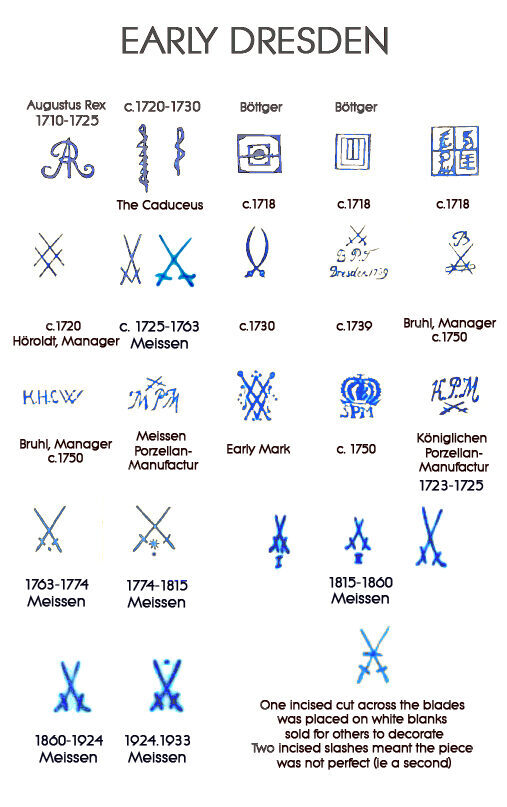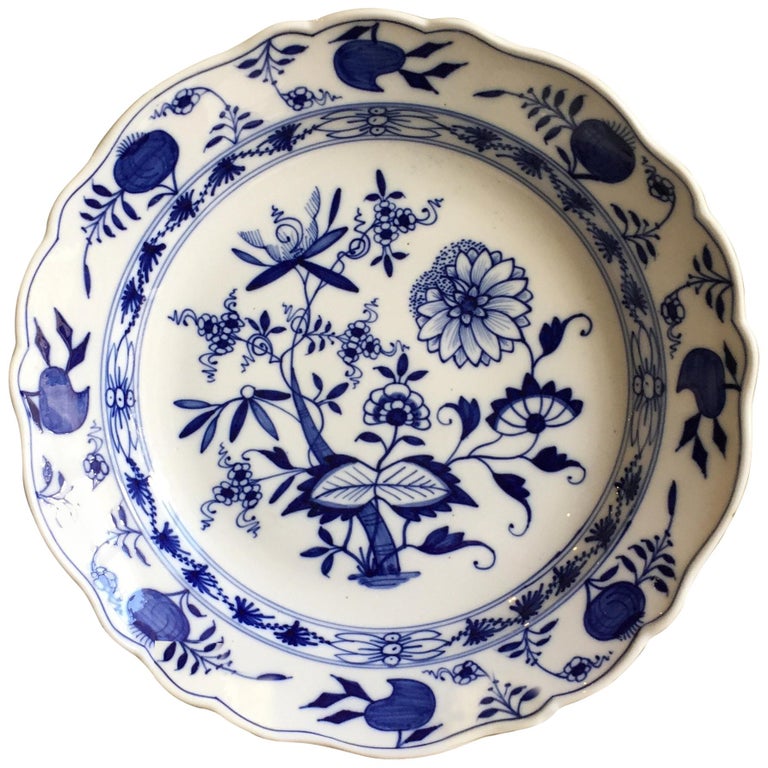
Pin on Antique
1 June 2023 A Meissen group of Columbine and Scaramouche 'Die Hahnreigruppe', circa 1741-45. Sold for £92,500 on 3 June 2015 at Christie's in London In the 18th century, porcelain — known at the time as 'white gold' — was one of the most highly prized commodities in the world.

RARE Meissen Plate Major Crossed Sword Porcelain Marks Handbook Ernst Wahliss 1798845315
Considered one of the most spectacular porcelain dinner services ever created, the Meissen "Swan Service" was conjured by designer Johann Joachim Kändler for Count Heinrich von Brühl, who became the director of Meissen in 1739. The full service was created between 1737 and 1742 and included more than 2,000 pieces.

Meissen porcelain marks
What is Meissen Pottery? History of Meissen Pottery Who Founded Meissen Pottery? What Inspired the Creation of Meissen Porcelain? How Did Meissen Porcelain Become Popular? Types of Meissen Porcelain 1. Porcelain Figurines 2. Tableware and Dinnerware 3. Vases and Decorative Pieces How is Meissen Porcelain Made? 1. The Clay and Mixing Process 2.

Meissen porcelain marks
Most porcelain marks on fine antique china, such as the Meissen marks, are "underglaze"--meaning, they were applied to the piece prior to firing. For the first hundred years or so of porcelain production there were only two known pigments that could withstand the high firing temperature necessary: iron red and cobalt blue.

Eearly Dresden and Meissen Marks on China
The History of The Crossed Swords Marks The Plate above illustrates the main Meissen Trade Marks since 1720 The Story of the origins of the Meissen Crossed Swords Trade Mark Since around AD 700 China had dominated porcelain making before the discovery of making porcelain at Meissen in 1707.

Meissen porcelain marks
Coordinates: 51°09′20″N 13°27′58″E Commedia dell'arte figures, c. 1740, 1744, 1735, modelled by Johann Joachim Kändler Meissen porcelain or Meissen china was the first European hard-paste porcelain. Early experiments were done in 1708 by Ehrenfried Walther von Tschirnhaus.

Meissen porcelain marks
No: 13 to 16 are imitation Chinese marks found on the blue and white porcelain of about 1720-25, and later. As early as 1721-22 the rare caduceus mark No: 17 appeared on some porcelain and to be applied occasionally until the early 1730's. The first true Meissen factory marks in underglaze blue No:19 to 20 found in 1723-24.

Meissen porcelain marks
The earliest markings of Meissen were AR, representing the king, Augustus Rex. This changed to two crossed swords around the year 1720 and was the consistent basis for the markings of Meissen porcelain from around 1730, following a royal decree.

Meissen Logos
Meissen porcelain, German hard-paste, or true, porcelain produced at the Meissen factory, near Dresden in Saxony (now Germany), from 1710 until the present day. It was the first successfully produced true porcelain in Europe and dominated the style of European porcelain manufactured until about 1756.
Meissen porcelain markings Antiques Board
Meissen was founded in 1710 in the gothic Albrechtburg castle. It was the first porcelain manufacturer in Europe. Originally situated in Dresden, in 1710 the factory was moved to the Albrechtsburg in Meissen, where it was more secure and easier to guard the secret of hard paste porcelain.

Meissen porcelain marks
Before you start searching for model numbers, please inform yourself about the marks and numbering of the Meissen® porcelain factory (Königliche und Staatliche Porzellanmanufaktur Meissen® GmbH). EXAMPLES FOR VARIOUS NUMBERING. For example: A 28, B 260, 1537, 73671, 85075.

Meissen porcelain marks
1. Meissen Company Marks 2. Qualifying or Quality Marks 3. Monogram & Signatures 4. Shape & Model Number Markings 5. Meissen Location Marks History of Meissen Porcelain Company Meissen Porcelain was the first hard paste porcelain to rise and popularize in Europe.

Meissen Blue Onion Porcelain Plate with 1815 Marks and Provenance For Sale at 1stdibs
The Meissen AR monogram was a special mark reserved for objects used by the court of Elector August the Strong, founder of the Meissen factory and later reigning monarch of Poland, King August II. It was also added to pieces produced for the court of his son, August III, who succeeded him in 1733.

Rare Meissen Marks
The Marks on Pottery and Porcelain are of three kinds—factory, workman, and pattern mark. Thefirst is usually placed in a prominent position, sometimes accompanied by the mark of the maker or decorator. Sévres Porcelain, for instance, often having four or five workmen's marks, besides that of the factory. The

FileMeissner Marken im Stadtmuseum Meißen.jpg Wikimedia Commons in 2020 Pottery marks
Written by Harry Rinker Meissen Porcelain - Description The Chinese and Japanese benefited greatly from the export of hard paste porcelain to Europe during the 17th and early 18th-century, a trade controlled by the Dutch East India Company. German and French royalty and aristocracy encouraged chemists to duplicate the formula.

Meissen porcelain marks
An assortment of meissen porcelain marks is available at 1stDibs. Each of these unique meissen porcelain marks was constructed with extraordinary care, often using ceramic, porcelain and metal.Meissen porcelain marks have long been popular, with older editions for sale from the 18th Century and newer versions made as recently as the 20th Century.